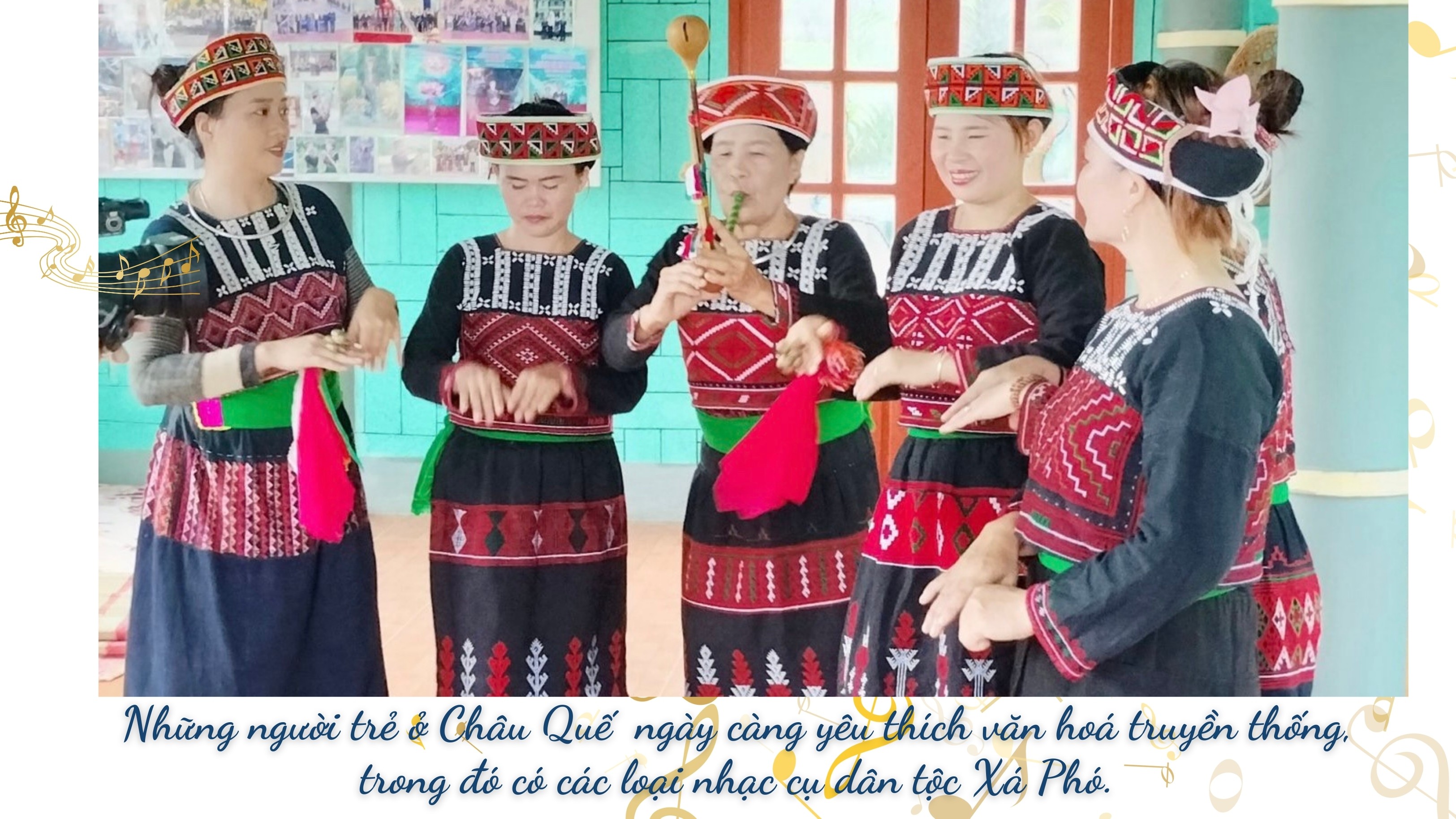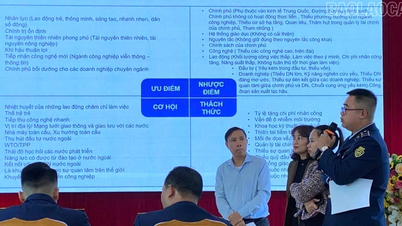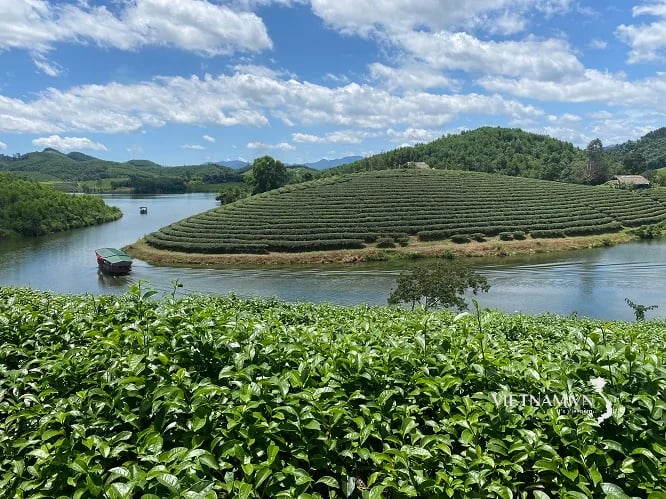On the vast green mountain slopes of Chau Que commune, there is a sound that does not belong to the wind, does not belong to the stream, but is the sound of the "cúc kè" flute - a strange musical instrument that only plays when the artist breathes through his nostrils, instead of blowing it with his mouth like a normal flute. That tone is both deep, high, and soulful like the call of the great forest, carrying the cultural soul of the Xa Pho people, quietly passing through time, passing from generation to generation.
The road leading us up to Ngoi Nhay village, Chau Que commune, was like a silk strip winding through the vast forest. On both sides of the road, the cinnamon hills continued layer upon layer, exuding a strong, slightly spicy aroma in the wind. The cinnamon scent permeated the breath, the clothes, and even the excitement of those searching for the ancient cultural traces of the Xa Pho ethnic group.
In a small house in the middle of the village, Meritorious Artisan Dang Thi Thanh holds a bamboo flute and gently guides some young people to play it. When the guests arrive, the nearly 70-year-old artist enthusiastically welcomes them. Pointing to the young people learning to play the flute, Ms. Thanh said: "Today is the weekend, we have a day off from work and school, so some children have come to my house to play and learn to play the nose flute. I am very happy that the children still like to learn like this. If all the young people today love it like this, the flute sound of the Xa Pho people will never be lost."

Then she led us closer to the group of young people practicing flute. Each breath, each stroke of her hand was slow but precise and delicate. She smiled, occasionally tilted her head to listen to the rhythm, then gently adjusted for each person: "To make the flute sound in the right rhythm, you must know how to regulate your breathing, focus on your nostrils, not your mouth. Be patient, the flute sound will follow your breath, will follow your soul to resonate."
Following the dedicated instructions of the grandmother, the excellent artisan, each young person hummed the rhythm, placed their hands on the flute, and watched each gesture attentively. The first flute sounds were still wavering, chirping like a baby bird calling its mate, but under the guidance of the grandmother, they gradually resonated clearly, clearly, flowing like a stream flowing across the mountainside. When they were able to blow into rhythm, the group of young people laughed loudly, their eyes sparkling with excitement.
In the past, the Xa Pho people often went to the fields all day, and often had to sleep overnight in the middle of the forest. On quiet, pitch-black nights, there was only the sound of the wind blowing through holes in dry bamboo trees, that sound mixed with the sound of leaves and the sound of the stream flowing like a piece of music. From there, the Xa Pho people came up with the idea of making the "cuc ke" bamboo flute. The "cuc ke" bamboo flute of the Xa Pho people only has one hole, and one must use breath through the nostrils to create a unique rhythm, so it is very difficult to blow, but when blown, it is very soft and airy.

Ms. Thanh further explained: “To have a standard flute, you must know how to choose bamboo. Xa Pho people only collect bamboo from September to December, absolutely not in the first months of the year because at that time the bamboo is often young and susceptible to termites. After being selected, the bamboo must be dried thoroughly before a single hole is punched at the end to be blown. The sound depends entirely on the way it is crafted, the dryness of the bamboo and the breath of the person blowing it. If you are not careful from the beginning, the sound will not resonate as desired.”
Confiding in old stories, the flute in Mrs. Thanh's hand suddenly rang out, gentle and poignant, spreading throughout the small house in the middle of the early morning mountain forest. The sound penetrated every corner of the house, blending with the rustling leaves in the yard, the chirping of birds, and the babbling of the stream in the distance. When the flute stopped playing, she still maintained her passionate look, her eyes shining with pride and deep love for the traditional art of her people.
At that moment, Dang Van Trung from Ngoi Nhay village - one of the young people learning to play the flute, smiled slightly and shared: “I like to play the nose flute because it is the cultural identity of my people. On normal days at work, on weekends or in my free time, I invite my friends to learn to play the flute with me. At first, it was very difficult, I had to practice taking deep breaths, holding my breath, and regulating my breathing rhythmically. But when the flute sounded, I felt like I was lost in the mountains and forests, hearing the sound of the wind and the leaves. It was truly magical.”

Sitting next to him, comrade Trieu Dinh Khai - Head of the Department of Culture and Society of Chau Que commune quietly listened, then slowly shared: "Currently, in the commune, there are 268 Xa Pho households with 1,007 people; mainly concentrated in Ngoi Nhay village with 156 households. Every year, to preserve and promote the traditional culture of ethnic groups in general and the Xa Pho ethnic group in particular, the commune regularly organizes propaganda to raise people's awareness. Particularly for the art of blowing the nose flute of the Xa Pho people, the commune organized a class to teach more than 20 people under the guidance of Meritorious Artisan Dang Thi Thanh.
Leaving Ngoi Nhay village in the late afternoon, the gentle but resonant sound of the flute echoes along the vast green mountain slopes as if conveying the heart of the artisan, of the young generation continuing the tradition. With the love and dedication of people like Meritorious Artisan Dang Thi Thanh and the young generation of Xa Pho people in Chau Que commune, surely that sound will be preserved, spread, and harmonize with the rhythm of community life and the breath of the times.
Presented by: Thanh Ba
Source: https://baolaocai.vn/tieng-sao-mui-cua-nguoi-xa-pho-post887468.html




































































































Comment (0)